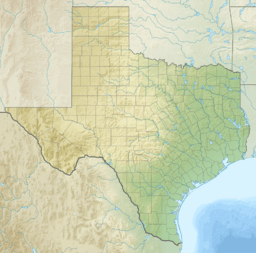East Bay (Texas) facts for kids
Quick facts for kids East Bay |
|
|---|---|

East Bay (left), off the shore of Bolivar Peninsula cut by the Intracoastal Waterway (center)
|
|
| Location | Texas Gulf Coast |
| Coordinates | 29°30′31″N 94°40′18″W / 29.508641°N 94.671764°W |
| River sources | Oyster Bayou, East Bay Bayou |
| Ocean/sea sources | Gulf of Mexico |
| Basin countries | United States |
| Settlements | Gilchrist, Smith Point, Port Bolivar |
East Bay, also called East Galveston Bay, is a large part of Galveston Bay in Chambers County, Texas. This bay stretches from northeast to southwest. It is about five miles wide and twenty miles long. East Bay is located north of the Bolivar Peninsula. It is south of the Texas mainland, where the small community of Smith Point is found. A smaller part of the bay, called Rollover Bay, is located to the far east near the town of Gilchrist.
A Look Back in Time
The Spanish controlled East Bay when they explored Texas. Back then, sea captains would often land their ships at Bolivar Peninsula. To avoid paying taxes in Galveston, they would roll goods across a small strip of land. They moved items between the Gulf of Mexico and a part of the bay called Rollover Bay. This is how Rollover Bay got its name!
Hundreds of years later, a natural water channel in this area was dug deeper. This created Rollover Pass. This new pass cut the town of Gilchrist in half. It also helped more water flow from the Gulf of Mexico into East Bay. This was good for Gilchrist's economy. Rollover Pass became one of the best fishing spots on the Texas coast. More seawater in East Bay helped fish and plants grow better.
In 1805, the Spanish landed on the northern shore of East Bay. This spot is now called Smith Point. They were there to protect their settlement nearby. About twenty years later, after Mexico was formed, the landing site was named for John Smith. He spoke out against the Mexican government's claims in the area. Soon, a small community grew there. People living in Smith Point relied on East Bay for food and travel. This was before cars became common. Some ranches also started along the bay. Fishing and ranching were the main jobs until oil was found in 1944. Since then, many oil and gas wells have been built both on land and in East Bay.
What Makes East Bay Special
East Bay gets its seawater from the Gulf of Mexico. This happens at Rollover Pass in Gilchrist. It also happens at Galveston Harbor near Port Bolivar.
The bay is fed by Oyster Bayou. This bayou is very important for young oysters and shrimp. It flows for 23 miles from its start near Winnie. It goes through the Anahuac National Wildlife Refuge. Then it joins East Bay near the bay's easternmost point. At this eastern point, the waters from East Bay Bayou and the Intracoastal Waterway also flow into the bay.
Protecting East Bay
The Galveston Bay Foundation works hard to protect and restore East Bay. They have brought back thousands of acres of wetlands. These wetlands are like nurseries for many kinds of fish. These important wetland areas also help protect the coast from strong storm surges. They also slow down the wearing away of the shoreline.
The foundation has worked with local people to put over 1,000 tons of oyster shells back into the bay. Oysters help clean the water by filtering out harmful metals. So far, the Galveston Bay Foundation has protected over 20 miles of shoreline. They have also restored almost 50 acres of salt marsh. They do this by creating "living shorelines." These shorelines help protect the land from erosion. Protecting the land from erosion is very important for wetlands. Studies of big storms, like Hurricane Ike, have shown how much damage erosion can cause.
See Also



